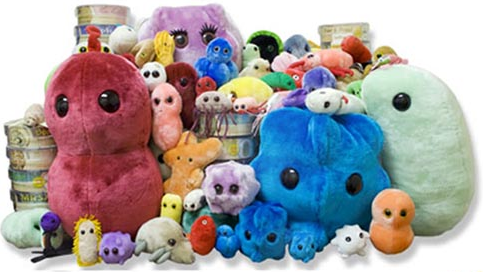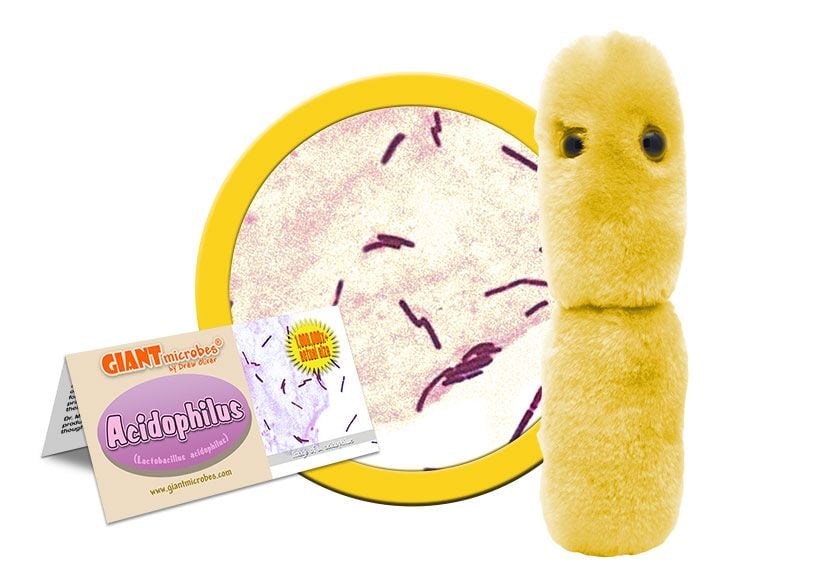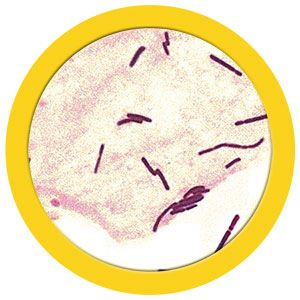Acidophilus (Lactobacillus acidophilus)
Just your "regular" guy, this bacteria helps your digestion and is actually good for you! Memorable and educational, this plush Acidophilus is here to help your learn about your gut health and probiotics.
Unique gift for students, biologists, educators, doctors, microbiome enthusiasts and anyone with a healthy sense of humor. Features high quality materials and includes an educational printed card with fascinating facts about this healthy bacteria.
Size: 7 x 2 x 2”
Product Details
Additional Information
| Sizes | Giantmicrobes are based on actual microbes, cells, organisms and other critters, only 1,000,000 times actual size! Gigantic (GG) 16-24" XL (XL) 10-15" Original (PD) 5-8" Keychain (KC) 2-4" with clip |
|---|---|
| Materials | Plush from all new materials. Stuffed with polyester fiber fill. Surface washable: sponge with water & soap, air dry. |
| Packaging | Each plush microbe includes a printed card with fun, educational and fascinating facts about the actual microbe or cell. |
| Safety | Every product meets or exceeds U.S. and European standards for safety. For ages 3 and up. |
All about Acidophilus (Lactobacillus acidophilus)
FACTS: Acidophilus is a probiotic bacteria that is commonly found in the human body. Probiotic means that it’s good for you!
How can bacteria be good for you? Well, all bacteria need resources to grow. But when benign bacteria such as acidophilus use up scarce resources, there aren’t enough to go around – and so harmful bacteria can’t survive. In addition, Acidophilus helps maintain an acidic environment in the body (by producing substances such as lactic acid and hydrogen peroxide) which discourages the growth of harmful bacteria.
Unfortunately, when you take antibiotics, acidophilus is killed along with the harmful bacteria that the antibiotics are designed to attack. This can lead to the intestinal indigestion that many people suffer when taking prescription drugs. In addition, since acidophilus is also credited with helping to control feminine yeast infections, it’s not surprising that these can also flare up when antibiotics are being taken.
Fortunately, you can replace your acidophilus by eating a lot of yogurt – which is often rich in acidophilus – or by taking herbal supplements. (To control yeast infections, topical application of yogurt is sometimes recommended!)
So the next time bacteria are getting to you, have the guts to give credit where it’s due. And remember that some bacteria are on your side – inside.
| Description | It produces hydrogen peroxide and enzymes to help break down the food we eat. Acid byproducts from digestion create an undesirable environment in the human gut for harmful bacteria, or pathogens. This prevents pathogens from attaching to the gut and causing damage. |
|---|
| Name | Lactobacillus comes from Latin root words lacto- and baci-, meaning milk rod. Acidophilus stems from acid- and philus-, meaning acid-loving. Put them together and you have acid-loving, rod-shaped bacteria that live in milk. |
|---|
| Actual Size | 0.6 x 1.5 micrometers, that’s 10 thousand times smaller than a pinto bean! |
|---|
| Where It Lives | Lactobacillus acidophilus is one of the species of bacteria naturally found in the human body, also known as normal flora. It’s used to make yogurt and probiotic supplements to promote digestive health. |
|---|
| History | It was first isolated in 1900 by Slovenian pediatrician, Ernst Moro. He was studying the bacteria involved in infant digestion. L. acidophilus was his first of many accomplishments and contributions to modern medicine. |
|---|
| Fascinating Facts | In 1908, Russian scientist and Nobel Laureate, Elie Metchnikoff, discovered that eating yogurt was linked to longer lives. Today, yogurt has become a billion dollar industry in the United States. That’s a lot of Acidophilus! |
|---|






